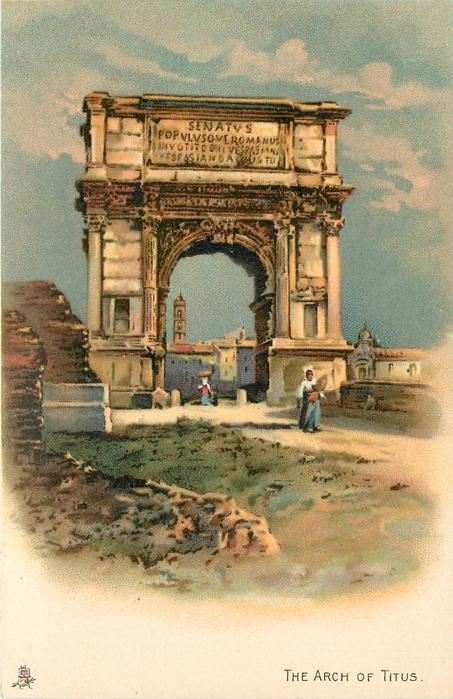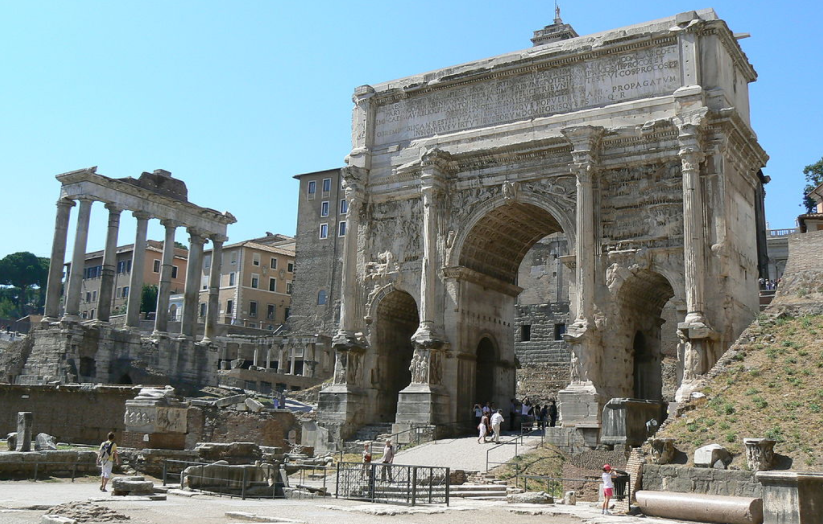Nathaniel Dancer
Arches: A Series, Part III
Rome, The Eternal City
Legend has it that twin brothers were left on a bank of the Tiber River and were rescued by a she-wolf. When Romulus and Remus were grown, they decided to build a city in their own honor, but they could not agree on a location. In a most unsatisfactory way Romulus settled the disagreement by killing his brother and naming the city Rome.
Have you noticed how often stories of fratricide have fidgeted their way into history? In the Bible we read of the first murder when Cain killed his brother Abel. In successive cultures, such as the Roman, Persian, Ottoman, and Mughal empires there are similar accounts or legends.
Two well-known examples remind us of the commonality of murder: Shakespeare’s Hamlet, when Claudius kills the elder Hamlet and marries his wife to take the throne, and in the animated Disney film The Lion King, Scar commits fratricide on Mufasa by casting him off a cliff.
These stories border on gruesome, but where do they fit into history? And is the crime always brother killing? Could the offense be a crime against humanity?
Upon examination of a “List of Roman Emperors” the scholar will fine 70 names. Their reigns began in 27 BC when Augustus began work on the 16th of January (a calculated date). He served more than 40 years. Afterward, some emperors served only a few days and others lasted decades. It is generally agreed that the end of the empire was when Romulus Augustus left power on September 4, 476 AD (also a calculated date). Of all of them the three we will examine here are the ones to whom triumphal arches are dedicated.
The Arch of Titus

Titus was born in 39, the son of Vespasian. Upon the death of his father in 79 when Titus was but forty years old, he seized power and served until his own death in September of 81.
Before becoming emperor, Titus gained fame as a military leader with his father. Together they fought in Judea, but when Nero died in 68 Vespasian quit the war to make a bid for Imperial Power. Success was his. He was declared emperor in 69 and that left Titus in charge of ending what was known as the Jewish Rebellion. A year later, nearly a decade before he, himself became emperor Titus was awarded his prize, the Arch of Titus.
Today the Titus arch sits in Rome’s ancient ruins, near the mid-city center, only a few hundred yards from the legendary Colosseum. The arch is oriented mostly east-west, where it stands 50 feet tall, 44 feet wide and 15 feet deep. The decorative motif, entitled the Spoils of Jerusalem, is one of military might and absolute power bestowed on Romans for use in world domination.
The inscription on the east side is:
SENATVS
POPVLVSQVE·ROMANVS
DIVO·TITO·DIVI·VESPASIANI·F(ILIO)
VESPASIANO·AVGVSTO, which when translated means; “The Senate and the Roman people (dedicate this) to the deified Titus Vespasian Augustus, son of the deified Vespasian.”
One very peculiar feature of the Titus arch is its keystone. On one side the keystone is adorned with the figure of a female, but on the other side of the keystone the figure is male.
The Arch of Lucius Septimius Severus

Lucius Septimius Severus was a Roman emperor for almost 18 years, starting in 193 when the Senate ordered the execution of his predecessor Marcus Didius Julianus who had been emperor for only nine weeks. Severus was proclaimed emperor by the Pannonian legions; he was 48 years old and thought to be what we call today, beyond it! He surprised many by living another 17+ years and he died of natural causes – quite an unusual way of dying among this lot.
The Arch of Septimius Severus stands at the northwest corner of the Roman forum just behind the Church of Saint Lucy and Saint Martina. It was built with white marble; one of the first pieces of public architecture to use the blue-grey Carrara marble quarried in the province of Liguria. When completed and dedicated in 203 to honor Septimius Severus and his two sons Carcalla and Geta, it was the largest memorial arch in the world. Larger in height by 25 feet and nearly double the width of the Titus arch and appropriately so for it honor three favorite sons of Rome.
After the death of Septimius Severus, his sons Caracalla and Geta were initially joint emperors, but here we go again, Caracalla arranged to have Geta murdered in 212, after which all memories of Geta were removed from public view.
The Arch of Constantine

Kōnstantînos was born in a part of the Roman Empire once known as Naissus. It is now in Serbia. The date of his birth is unknown but thought to be around 272.
Constantine became the emperor in 306 when his father Constantius died. His father had served the Empire as an Illyrian army officer who became one of the four emperors of the Tetrarchy. His mother, Helena, was Greek, but was as they said, “of low birth.”
After considerable service in the eastern provinces against barbarians and Persians, Constantine was recalled around 305 to join his father in the wars in Britain. When his father died Constantine was acclaimed emperor by the army at Eboracum (later to become York).
The reign of Constantine is often considered a time of relative peace, but the facts are, in that era, peace meant that only fewer people were murdered, executed, or assassinated in the pursuit of imperial power. Constantine emerged victorious in the civil wars against his several rival emperors, namely Maxentius and Licinius. When Licinius was defeated, deposed, and put to death by Constantine it was only then that he became sole ruler of the Roman Empire until his death on May 22, 337. He was 65 and another of the few who died of natural causes. His reign as an emperor lasted nearly 32 years
The arch of Constantine stands alone in the midst of traffic at the south-west corner of the Piazza del Colosseo. Less than 100 yards from the Colosseum. It is a mighty site, although since the protective fences have been added the aura of antiquity is much diminished.
The decorative motif is much like other arches. “Military power preserves the peace.”
To recap, you who are among the most determined readers will surely observe that the arches of Septimius Severus and Constantine have three portals. If you care to participate in the “Higher Examination” in Roman Arches, please render your remarks in the comments section below. Thank you, N&S.
This article will help me appreciate the arches more if I ever make it to Rome!